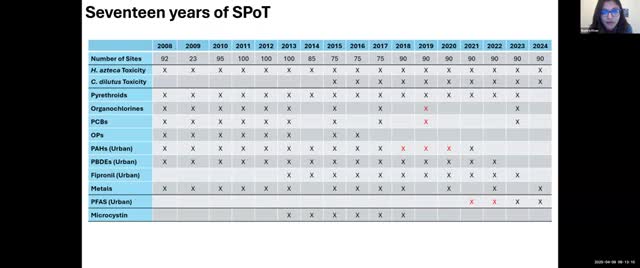California spot monitoring program marks eighteenth year with toxic analysis updates
April 26, 2025 | California Water Quality Monitoring Council, Boards and Commissions, Executive, California
This article was created by AI summarizing key points discussed. AI makes mistakes, so for full details and context, please refer to the video of the full meeting. Please report any errors so we can fix them. Report an error »

The California Water Quality Monitoring Council's recent meeting highlighted significant developments in the ongoing SPoT monitoring program, now in its eighteenth year. A key focus was the analysis of water quality data collected from various sites across the state, particularly concerning urban areas.
During the meeting, officials presented a comprehensive overview of the program's history, detailing the number of sites monitored each year and the types of analyses conducted. Notably, the introduction of new analytes, including PFAS, was discussed, with officials noting that only two years of data from 2023 and 2024 have been deemed reliable for trend analysis due to quality assurance concerns in earlier datasets.
The meeting emphasized the importance of statistical methods, specifically the Mann Kendall test, which is used to identify trends in water quality data. This method allows for the assessment of both site-specific and statewide trends without being skewed by irregular sampling periods or missing data. The results categorize trends as upward, downward, or stable, providing valuable insights into the health of California's water systems.
Officials also pointed out that the interpretation of statewide trends can vary significantly based on the number of sites included in the analysis. This raises important questions about how these trends should be understood in the context of California's vast geography and diverse water quality challenges.
As the SPoT program continues to evolve, the discussions from this meeting underscore the commitment to ensuring safe and clean water for all Californians. The findings from ongoing analyses will play a crucial role in shaping future water quality policies and initiatives, directly impacting the health and well-being of communities across the state.
During the meeting, officials presented a comprehensive overview of the program's history, detailing the number of sites monitored each year and the types of analyses conducted. Notably, the introduction of new analytes, including PFAS, was discussed, with officials noting that only two years of data from 2023 and 2024 have been deemed reliable for trend analysis due to quality assurance concerns in earlier datasets.
The meeting emphasized the importance of statistical methods, specifically the Mann Kendall test, which is used to identify trends in water quality data. This method allows for the assessment of both site-specific and statewide trends without being skewed by irregular sampling periods or missing data. The results categorize trends as upward, downward, or stable, providing valuable insights into the health of California's water systems.
Officials also pointed out that the interpretation of statewide trends can vary significantly based on the number of sites included in the analysis. This raises important questions about how these trends should be understood in the context of California's vast geography and diverse water quality challenges.
As the SPoT program continues to evolve, the discussions from this meeting underscore the commitment to ensuring safe and clean water for all Californians. The findings from ongoing analyses will play a crucial role in shaping future water quality policies and initiatives, directly impacting the health and well-being of communities across the state.
View full meeting
This article is based on a recent meeting—watch the full video and explore the complete transcript for deeper insights into the discussion.
View full meeting
